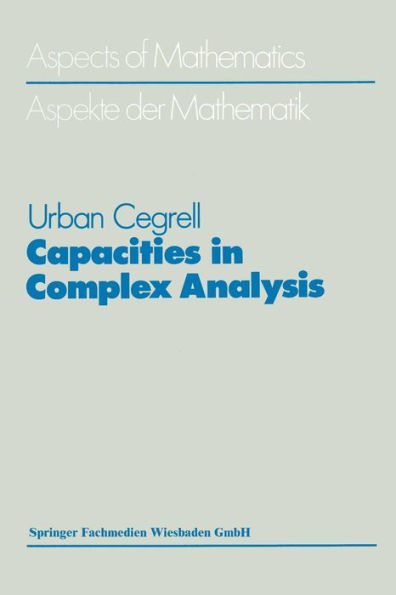Capacities in Complex Analysis
The purpose of this book is to study plurisubharmonic and analytic functions in n using capacity theory. The case n=l has been studied for a long time and is very well understood. The theory has been generalized to mn and the results are in many cases similar to the situation in . However, these results are not so well adapted to complex analysis in several variables - they are more related to harmonic than plurihar- monic functions. Capacities can be thought of as a non-linear generali- zation of measures; capacities are set functions and many of the capacities considered here can be obtained as envelopes of measures. In the mn theory, the link between functions and capa- cities is often the Laplace operator - the corresponding link in the n theory is the complex Monge-Ampere operator. This operator is non-linear (it is n-linear) while the Laplace operator is linear. This explains why the theories in mn and n differ considerably. For example, the sum of two harmonic functions is harmonic, but it can happen that the sum of two plurisubharmonic functions has positive Monge-Ampere mass while each of the two functions has vanishing Monge-Ampere mass. To give an example of similarities and differences, consider the following statements. Assume first that is an open subset VIII of n and that K is a closed subset of Q. Consider the following properties that K mayor may not have.
1118017115
Capacities in Complex Analysis
The purpose of this book is to study plurisubharmonic and analytic functions in n using capacity theory. The case n=l has been studied for a long time and is very well understood. The theory has been generalized to mn and the results are in many cases similar to the situation in . However, these results are not so well adapted to complex analysis in several variables - they are more related to harmonic than plurihar- monic functions. Capacities can be thought of as a non-linear generali- zation of measures; capacities are set functions and many of the capacities considered here can be obtained as envelopes of measures. In the mn theory, the link between functions and capa- cities is often the Laplace operator - the corresponding link in the n theory is the complex Monge-Ampere operator. This operator is non-linear (it is n-linear) while the Laplace operator is linear. This explains why the theories in mn and n differ considerably. For example, the sum of two harmonic functions is harmonic, but it can happen that the sum of two plurisubharmonic functions has positive Monge-Ampere mass while each of the two functions has vanishing Monge-Ampere mass. To give an example of similarities and differences, consider the following statements. Assume first that is an open subset VIII of n and that K is a closed subset of Q. Consider the following properties that K mayor may not have.
59.99
In Stock
5
1

Capacities in Complex Analysis
156
Capacities in Complex Analysis
156Paperback(1988)
$59.99
59.99
In Stock

Product Details
| ISBN-13: | 9783528063351 |
|---|---|
| Publisher: | Vieweg+Teubner Verlag |
| Publication date: | 01/01/1988 |
| Series: | Aspects of Mathematics , #14 |
| Edition description: | 1988 |
| Pages: | 156 |
| Product dimensions: | 6.10(w) x 9.25(h) x 0.01(d) |
| Language: | German |
From the B&N Reads Blog
